Traditional Japanese strategies for combatting natsubate, or the dog days of summer
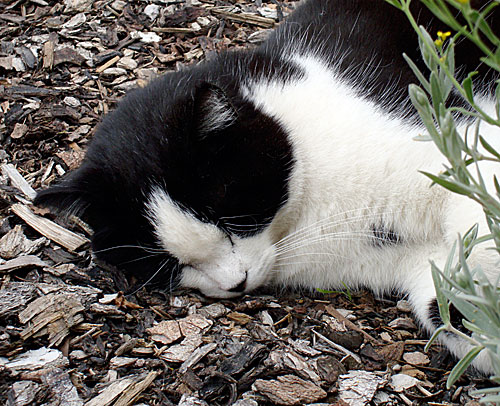
A cat of our acquaintance's natsubate strategy: All-day naps in the shade.
August is particularly bad in the Tokyo area where I'm from, as it is in most parts of Japan except for the northern parts of Hokkaido. It gets really hot, and the high humidity makes everything and everyone moist, sticky and generally nasty. There's a bit of relief in the form of a brief evening thunderstorm (夕立 ゆうだち yuudachi) most days, but the respite is temporary. Getting a decent night's sleep without air conditioning is pretty much impossible.
The term to describe the stage of lethargy and fatigue brought on by this hot, humid weather is 夏バテ (なつばて natsubabe; literally 'summer fatigue'). Japanese people have devised various ways of combatting it. Some are food related, and some aren't, but here are some of my favorites.
Eat and drink very cold things
An obvious strategy perhaps! It does mean that there are lots of delicious cool drinks and snacks in Japan. My favorite cool summer drink is mugicha or roasted barley tea.
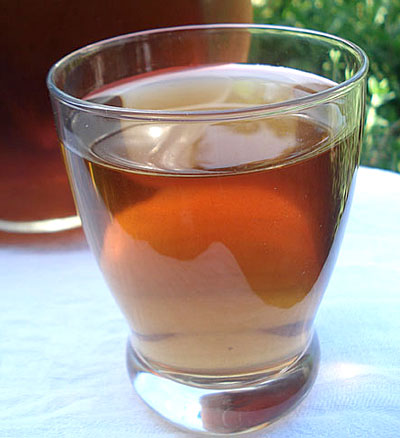
Other quintessentially Japanese summer drinks include ramune, a lemony drink that traditionally came in a glass bottle stoppered with a marble (the word ramune is derived from the English 'lemonade'); iced coffee, which can be served black, with sugar, or with milk and sugar, and is a popular vending machine item; and Calpis, a fermented, sweet milk-based drink (more about Calpis in another post!) Ice cold beer and sake are very popular too. Surprisingly perhaps, iced green tea is a fairly recent invention, promoted by bottled drink manufacturers.
To digress: Ice cube culture!
In Japan, cold drinks are usually served with lots of ice, either cubes or crushed. The same goes for the U.S. But here in Europe, cold drinks are often served with no ice cubes at all. Even places like McDonalds (which are all over France, especially in this area) only include 2 to 3 measly ice cubes in their drinks. When I ask people here about this I get two explanations: Ice cubes dilute the drink; or ice cubes are bad for your digestive system. (But if ice cold things are so bad for the tummy, why all the ice cream?) I love to crunch down on ice cubes when it's hot, so I feel deprived!
Anyway, back to the subject...
A traditional ice cold snack is of course kakigouri (かき氷 かきごうり) or shaved ice, topped with sticky-sweet fruit flavored syrup. Here's a Hawaiian version that I had in November...
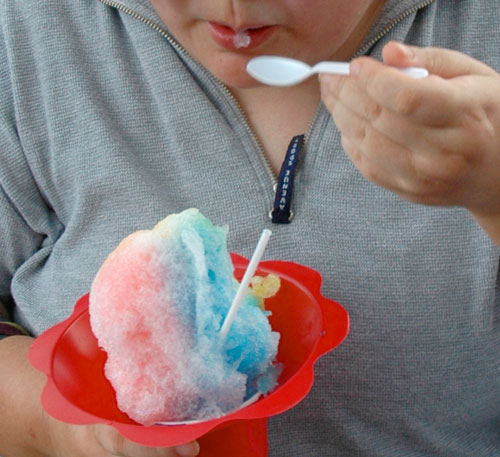
Ice cream is popular too, though not exactly traditional. Nowadays rich, creamy brands like Häagen-Dazs (ハーゲンダッツ in Japan) are all the rage, but the ice cream I remember eating growing up was thinner and lighter, more like ice milk. It either came in little paper tubs, or as monaka, in a waffle-shaped wafer covering. (Yuki daifuku, an ice cream filled dumpling, is a fairly recent invention from the 1980s or so.)
Other cool snacks include mitsumame (みつ豆), a sort of fruit cocktail with cubes of kanten (agar-agar) and cooked azuki beans; anmitsu (あんみつ), soft rice dumplings (called shiratama) with sweet azuki beans (an) and fruit; and kureemu anmitsu (クリームあんみつ), animitsu with vanilla ice cream. Here's my very derivative version of kureemu anmitsu, using strawberries in balsamic vinegar instead of sugar-syrup. Below is a more traditional kureemu anmitsu by yumiko tanaka.
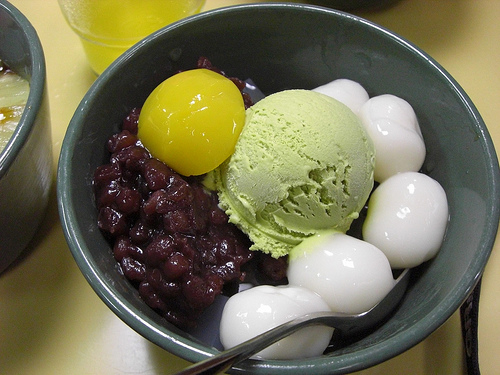
There's even a savory cool snack, called tokoroten(ところてん), thick noodles made from a seaweed called isinglass, with a vinegar-soy sauce sauce, topped with hot mustard and other things. Tokoroten is almost no-calorie if you use the eastern Japan style vinegar sauce. (In western Japan a sweet sauce is used instead.) The slippery texture may take some getting used to though. Heres a photo by CookieM.
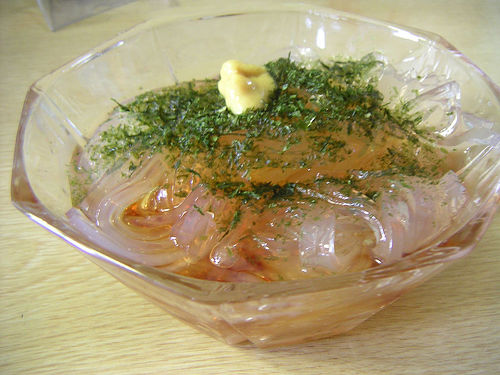
Other cooling foods, from chilled salads to watery vegetables like cucumbers and eggplants (aubergines) are consumed to cool down the body. A popular easy to eat meal is cold noodles - soba (buckwheat noodles), so-men (very thin wheat noodles), _hiyashi chuuka_, udon and so on.
Give 'em sutamina (stamina)!
Another way to combat natsubate seems diametrically opposed to the cool, cold food and drink strategy is to eat rich, oily foods, to give the lethargic body sutanmina or stamina, or seiryoku (精力 seiryoku), which can mean energy in general or sexual energy. A quintessential stamina-giving oil rich food is eel (unagi), in the form of unajuu (うな重 うなじゅう), a bed of plain rice covered with filets of unagi in a savory-sweet sauce. Here's a photo from HisashiToday:
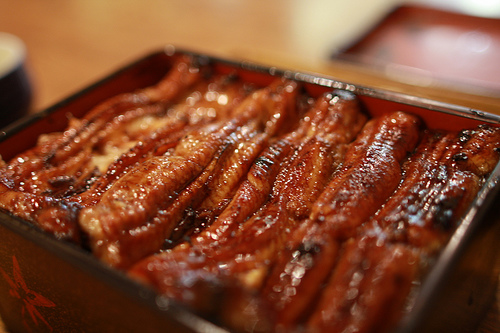
Some assert that sutamina can be gained by eating organ meats. There are little restaurants that specialize in grilled organ meats, called horumon yaki (ホルモン焼き ほるもんやき), literally translated as 'grilled hormone'! Typical horumon yaki ingredients include things like hatsu (heart), motsu (kidney or stomach), hatsu (heart), tripe, and other innards from pigs (and boars), cows, and poultry.
Other sutamina giving foods include garlic, ginger and spicy foods (especially curry).
An umeboshi a day...
I have fond memories of going to stay at my grandparents' during summer vacation. After playing out in the hot sun all day, my grandmother would always insist on my cousins and me having a salty umeboshi each. Umeboshi went a bit out of fashion for a while, due to concerns about high sodium, but they seem to be coming back in style now, since they are supposed to quite good for you, despite the salt.
Wear a yukata
A yukata (浴衣 ゆかた) is a casual summer kimono. Usually made of cotton or a cotton-linen blend tht is cool on the skin (formal kimonos are often made of silk, wool or similar synthetics), it's most often worn in the evenings after taking a cool shower or bath. (Yukata literally means 'bathing clothes'). A yukata is worn both outside and as sleepwear. (Photo by ori2uru.)
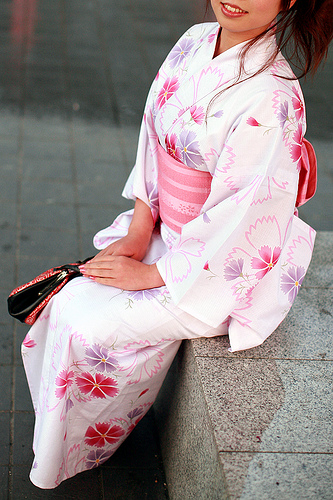
Traditionally, new yukata are made for each member of the family every summer. In my mother's day, girls would often have to make a yukata as part of their summer vacation homework, by hand. (Yep in Japan they issue homework for the holidays!) In my day this had changed to making anything crafty (I remember making a raffia bag one year, a skirt another); I wish I had learned how to sew a yukata instead. There is a terrific short-story manga by my favorite manga author, Moto Hagio, called "The Yukata That Sayo Sews" (小夜の縫うゆかた), a sweet story about how 14-year old Sayo trying to decide whether or not to use the rather childish dragonfly-print fabric that her mother had bought the year before to make her homework yukata. Her mother had passed away before she had been able to sew that fabric into a yukata for Sayo...
A wind bell (fuurin)
Finally, one of my favorite non-food ways of keeping cool is to hang a fuurin (風鈴 ふうりん) outside the window. A fuurin (literally 'wind bell') is a small metal, ceramic or glass bell, with a little paper tag hanging from the ringer part. When the wind blows, the bell make a small, high pitched sound. This sound is supposed to evoke coolness. Great care is given to choosing a bell with just the right chime. (Photo by r.g+.)
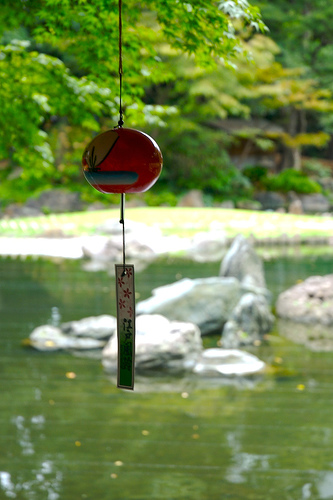
In principle a fuurin is related to those big, clunky wind chimes, but far more delicate. (Incidentally, one of the most jarring moments for me in the movie Memoirs of a Geisha, which is riddled with cultural inaccuracies, was when a fuurin was seen hanging outside in the dead of winter and used as a doorbell. Wrong, so wrong!)
What are you favorite ways of keeping cool?
If you enjoyed this article, please consider becoming my patron via Patreon. ^_^

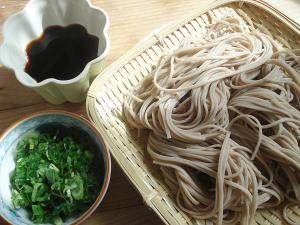
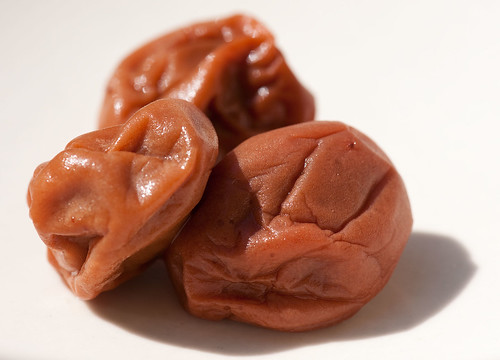
 Welcome to Just Hungry, where we serve authentic Japanese recipes and more! I'm
Welcome to Just Hungry, where we serve authentic Japanese recipes and more! I'm 












Comments
kim
6 August, 2009 - 13:25
Permalink
Re: Traditional Japanese strategies for combatting ...
Great list! I had read about "summer fatigue" in some mangas but couldn't quite grasp what they were talking about.
lisa
6 August, 2009 - 15:29
Permalink
Re: Traditional Japanese strategies for combatting ...
Hi. Thanks for this post - it is very timely as it is extremely hot in NYC these days!
I wanted to point out, for the sake of vegetarians especially, that as far as I can tell from other sites, tokoroten is made from agar/kanten, which is sometimes called "Japanese isinglass" according to Wikipedia. "Isinglass" without the qualifier "Japanese" refers to the swimbladders of fish, and is an animal-derived product (sometimes used in the making of beer).
Calixti
6 August, 2009 - 15:38
Permalink
Re: Traditional Japanese strategies for combatting ...
Japanese summers sound suspiciously like Nebraska summers. Which I mostly combat by staying indoors unless it's very early or very late whenever possible, getting to bus stops at the last possible moment when I need to go somewhere (the buses are air-conditioned), and drinking lots of iced mint tea. Cotton clothes are kind of a mainstay for me, rather than a summer-specific thing, but I see the sensibility behind yukatas too.
Veron
6 August, 2009 - 16:32
Permalink
Re: Traditional Japanese strategies for combatting ...
It's funny you posted this about unagi. I was in the japanese store this past weekend and I was telling the ladies behind the counter how I love unagi and she said that in the summer, people in Japan eats lots of unagi to give stamina. Well, it'll be 98 degrees F next week so guess what I'll be eating. :)
Meaghan
6 August, 2009 - 17:08
Permalink
Re: Traditional Japanese strategies for combatting ...
Hi Maki, thanks for the great list! I love mugicha, too, but was introduced to it in Korea, where it is boricha. Really cold barley tea is so nice on a hot day.Strangely, this year in Montreal we have not had any hot weather to speak of, so I haven't gotten a chance to employ any cool-down strategies yet.
Nath
6 August, 2009 - 17:30
Permalink
Re: Traditional Japanese strategies for combatting ...
Thank you for the post. I would love to taste the kureemu anmitsu. As for keeping cool, well I live in Ireland, that is not a problem for me!
Lorena
6 August, 2009 - 18:14
Permalink
Re: Traditional Japanese strategies for combatting ...
Well, it's been pretty hot and humid in Southern California these past few days. So, I've been staying cool by reading manga indoors and eating lots of salads, fresh cold fruit and grilling outdoors.
For refreshing drinks, I like ice cold teas, like iced black tea or Trader Joe's red chai (it's a red rooibos tea with chai seasonings). Of course, a nice local microbrew beer is pretty nice, too, especially if we're doing a "snack" dinner -- which basically consist of appetizer-like components that we combine into a meal with a salad on the side. Our most recent snack dinner involved spring rolls, pan-fried gyoza and salad with a spicy Asian-styled vinaigrette.
Oh, and mitsumame is reminiscent of Filipino halo-halo, a parfait of sorts involving shaved ice, milk, fruit and sweet beans. Makes me wonder what came first -- mitsumame or halo-halo!
reiyano
6 August, 2009 - 18:57
Permalink
vending machines everywhere!
So while I lived in Japan I always made notice of the amount of vending machines all over the place. ofc it was not summer yet and so when it finally did hit I had an epiphany. I finally understood that during the worst of it you drag yourself from vending machine to vending machine to get something cool to drink like cold tea, calpis, pocari sweat, or one of my favorite things to drink was Qoo. I love the little Qoo mascot =)
anon.
6 August, 2009 - 20:41
Permalink
Re: Traditional Japanese strategies for combatting ...
I was in Japan exactly one year ago and all I really remember is being constantly hot and sweaty and drinking mugicha EVERYWHERE.
thanks for the great article.
I would love to hear about more of the inaccuracies in Memoirs...
Karla
6 August, 2009 - 22:30
Permalink
Re: Traditional Japanese strategies for combatting ...
Ditto the reply about Southern California! And luckily, the fruit is indeed lovely this year. I developed a love for Mugicha when I lived in Tokyo. I still adore it, and drink it regularly. It's great for those who don't do caffeine of soft drinks well. The summers in Japan were barbaric! I used to take the train out of Tokyo to a big park named Inokashira Koen. Even if it wasn't all that much cooler, wandering through the trees and the shade was so enjoyable. Ice cold beer took on a new meaning... especially in the evenings in my yukata!
Aki
7 August, 2009 - 00:21
Permalink
Re: Traditional Japanese strategies for combatting ...
Love your blog! and love the sound of the fuurin! It gives you the feel of that momentary cool breeze in that hot hot weather, and always reminds me of the summers I spent as a child in Tokyo. Thanks for the memory!
kanmuri
7 August, 2009 - 01:57
Permalink
Re: Traditional Japanese strategies for combatting ...
Great post! Just wanted to tell you tho that horumon (ホルモン)
in Japanese does not translate to the English "hormone". The word horumon comes from the kansai region. People used to throw away the organs, not eating them. "Horu", means to throw away and "mon" comes from mono (物). So horu-mon means "things we throw away." Apparently, eating horumon only started after World War 2, when food was scant.
maki
7 August, 2009 - 05:45
Permalink
Re: Traditional Japanese strategies for combatting ...
According to Wikipedia Japan (not an authoratative source I know...) there are two theories as to the origins of 'horumon': one is the theory I stated (horumon = hormone = stamina), and the other you stated. I must remember the incident that is described there where some TV program debunked the theory you stated. Anyway, I guess it could mean either! I do remember that my dad (not a Kansai-jin, who used to be a big horumonyaki fan, until he got very overweight, got type 2 diabetes, and dropped about 30kg) always went by the horumon=stamina theory to justify his er, habit ^_^
Shaney
7 August, 2009 - 03:25
Permalink
Re: Traditional Japanese strategies for combatting ...
I'm actually a little jealous. I'm in Bristol (UK) and while it's been very humid, and very very wet, it's not been particularly warm. We did have a week or two a while back, but not the long hot summer I was hoping for.
Normally I don't really like the heat. However it's been so long since we've had a real 'kick off the sheets because it's too warm' summer that I'm actually missing it. I want to wear summer clothes and eat ice cream again!
kakugori
7 August, 2009 - 08:47
Permalink
Re: Traditional Japanese strategies for combatting ...
Ha ha, many familiar things in this post, including the lazy summertime cat. Lots of cold drinks (mmm, crunchy ice is good) and frozen items. I need no excuses to eat more unagi, and I've been seriously considering buying a yukata lately. One of the more amusing ways to keep cool is widely practiced by stores in the French Quarter of New Orleans--just crank the AC way, way up and leave the doors open, and the tourists will at least flock to the doorways.
It's time for grapes here, and I just came home from a 111th annual Grape Festival famous for it's fried chicken and spaghetti dinners, local grapes for sale, and more recently the sale of grape ice cream. By far one of my favorite flavors. Though I think part of Japan is known for grapes and grape ice cream?
Fun fact: my English-Japanese dictionary tells me that ice cube translates as
角氷, or 'Kakugori'. Whether this is the correct use or no, it's made for a great username :)
Pat
7 August, 2009 - 21:54
Permalink
Re: Traditional Japanese strategies for combatting ...
I love anything grape-flavored! I never tried grape ice cream, though. Now that I think about it, why isn't there grape ice cream (in regular supermarkets)!?!
kakugori
8 August, 2009 - 01:47
Permalink
Re: Traditional Japanese strategies for combatting ...
I know, right?! Ben and Jerry's, etc. are really missing out. At least a sherbet or something? It's pretty easy to make it yourself, though, if you have an ice cream maker.
new2bento
7 August, 2009 - 13:31
Permalink
Re: Traditional Japanese strategies for combatting ...
Just reading your post makes me hot. Living in Miami it's natsubate every day in the summer. Thank goodness for air conditioning. Back in the summer of 1992 we lost our power for over two months. I took a cold shower three times a day. I couldn't get enough icecream...I wish I knew how to make a yukata it is absolutely beautiful. Thanks for the lesson on culture.
Takat
7 August, 2009 - 13:54
Permalink
Re: Traditional Japanese strategies for combatting ...
Wow, that first paragraph describes some of the places I visited in China perfectly! The heat and sun could get unbearable. Unfortunately, I dislike Chinese ice-cream, and they don't like putting ice cubes in drinks either!
Wish I'd had access to some of these wonderful sounding treats. Though I suppose I tasted my share of delicious food!
Takat
Takat
Writing away about my latest 3 week adventure through China at http://katacomb.blogspot.com
jenib
7 August, 2009 - 16:01
Permalink
Re: Traditional Japanese strategies for combatting ...
While reading I had to laugh. I live in Baltimore, MD USA where it is famously humid and hot in summer. We too eat shaved ice with sweet syrups drizzled over it, some concoctions are closely-guarded homemade recipes. We call them "snowballs" and snowball stands are everywhere. It's August now, usually the toughest month to suffer through, (referred to as the "dog days of summer")and the heat is still bearable, an unusual summer. Another great way to beat the heat here is to go swimming, preferably going "down the ocean" to do it!! I will be trying some cold noodles soon. Here's to summertime on opposite sides of the globe!
hmw0029
8 August, 2009 - 14:52
Permalink
Re: Traditional Japanese strategies for combatting ...
Baltimore is not that bad. I live in St. Louis and I thought I was experiencing similar hot & humid summers compared to Japan.
WRONG! after 7 years of not going back in Japan in summer I realized it is possible for humidity to be even higher. And Japanese people try not to use A/C as much as possible (no central air for most houses), so using things listed above is critical :-)
Maki-san, your post reminded me that I used to love drizzling concentrated calpis on my shaved ice! we used to get different flavor ones for Oseibo.
Elaine@kitchene...
8 August, 2009 - 07:03
Permalink
Re: Traditional Japanese strategies for combatting ...
One of my favorite ways to keep cool during hot, humid days is eating a very cold slice of watermelon. But summer has been quite mild here in Montreal, it's almost skipping a season and going right into autumn with a 13C temperature right now.
Nick
8 August, 2009 - 14:59
Permalink
Re: Traditional Japanese strategies for combatting ...
NATSUBATTA!!!
My wife's mums old relatives send a summer parcel every year to us here in Kyushu(Chugen I think its called.)..Shimane prefecture is famous in Japan for a specific dwarved red seedless grape. She sends a truckload every year...We give some away as Omiage(souvenirs) but freeze most. They are awesome as an icecream style, combat the heat treat during this oppressive heat here. freeze your grapes folks..they are great!
petitegeek
9 August, 2009 - 16:42
Permalink
Re: Traditional Japanese strategies for combatting ...
Living in the sweltering heat of Kyoto, we only get by with a) air-con b) Hiyayakko Tofu (thanks Maki!) and c) heading to the river where a breeze manages to find a path through the city, especially when we realize how much air-conditioning costs!
vamullen
11 August, 2009 - 00:55
Permalink
Re: Traditional Japanese strategies for combatting ...
I've been trying to be more conscious of the use of electricity in my house as of late, and Air conditioning is one of the big things. We have to keep our heat low in the winter to keep natural gas bills down, so by the time summer rolls around I'm used to sleeping in sixty degree rooms! So, you can guess that I like to keep my AC low in the summer to get some sleep.
So to combat the heat enough that I can sleep? Lots of water, getting what I need to get done in the early hours of the day, and keeping my room dark by keeping the shades drawn. It's gotten to the point that I can keep the AC off during the day, since the other two in the house have to be on to keep the dogs cool.
ninetteenrique
11 August, 2009 - 04:14
Permalink
Re: Traditional Japanese strategies for combatting ...
I loved reading this post. Reminds me when I lived in Tokyo and had to commute all over the place in that ungodly weather. Better than in June though and monsoon season. Now that was a trial!
Fiona
11 August, 2009 - 15:08
Permalink
Re: Traditional Japanese strategies for combatting ...
Iced earl grey. : )
It's currently raining here in Glasgow, but when it is warm, I sometimes make iced earl grey -- usually some 6-8 bags stewed in 1 cup of water to make a concentrate, then dump it into a jug of cold water, and add lots of lemon and ice to it.
I used to make iced coffee as well -- generally by cold brewing it overnight -- 4 tablespoonfuls -- in a cafetiere (it seems to keep it from getting bitter, gives it a sweeter taste), and then swapping the mixture into a clean jug in the morning, and adding condensed milk. I can't drink coffee anymore, though, because it ends up making me very jittery.
I've also used your cold soba noodles recipe now and then as well. ^_^ It's very enjoyable.
Kime-chan
11 August, 2009 - 20:00
Permalink
Re: Traditional Japanese strategies for combatting ...
I was in Osaka with my husband in June and we had the best frozen yogurt at a little shop on the 7th floor of Yodobashi Camera called Yami Yogurt. We still mention it once in a while. We keep saying that if (hopefully when) we go back to Japan again that we need to go get more!
The frozen yogurt there puts the stuff here to shame.
I live in Utah, so it's a very dry, but very high heat. I love taking a cool shower or bath right before bed. I'll also take an ice-pack sometimes and lay it on my chest or stomach when I go to bed. It helps lower my core temperature a bit and cools me down enough so that I can get to sleep. I'm also a fan of getting a large shaved ice at one of the many small stands here.
Pat
11 August, 2009 - 21:31
Permalink
Re: Traditional Japanese strategies for combatting ...
Ice cream, iced tea, summer dresses, and leaving the fan on 24/7 (still cheaper than occasional A/C). I also like to dampen a washcloth with cold water and wipe my arms and neck...feels nice and cool as the moisture evaporate from your skin. I got 3 yukatas from ebay, and LOVE how comfortable they are (I don't use the wide obi, I wear it the way Otsu does in Samurai Trilogy). It is my year-round lounge wear. I can't say that it keeps me cooler than a tank top and shorts, but definitely more comfortable. In colder weather, I wear it over my PJs. Good for laundry days too.
Winegrrl
12 August, 2009 - 20:33
Permalink
Re: Traditional Japanese strategies for combatting ...
Your kureemu anmitsu reminds me of halo-halo...
Andree
Ellydishes
18 August, 2009 - 05:16
Permalink
Re: Traditional Japanese strategies for combatting ...
I just moved to Japan two months ago and am just tremendously enjoying your entries! I've known about your blog for a long time (it's kinda famous!) but never had a chance until now to read through it. And I love, love, loved this entry, what a perfect list!
(P.S. Memoirs drives me up the wall, too... ugh.)
Robyn
22 August, 2009 - 03:47
Permalink
Re: Traditional Japanese strategies for combatting ...
As always, lovely post, Maki. When I first lived in Japan (in ぼんち Kyoto) in the early 70s I was most taken by just how many things were done to provide mental relief from summer's heat & humidity. Even in tiny homes there appeared from storage beautiful summer crockery often in cool blues & whites or glass, summery chopstick rests, coasters, oshibori (おしぼ り)rests, and of course the oshibori (small moistened cloth to cleanse hands) themselves would be produced from the fridge so deliciously cool, noren (のれん)doorway curtains too in light summer tones, thin summer cushions covered in cool to the touch weave(? reeds or rice straw), sudare(すだれ)blinds made from reeds to provide shade at windows and doorways while allowing the passage of any tiny breeze and yes furin (ふりん). I appreciated my towelkette (a sheet made from cotton towelling) which absorbed moisture at night. I was fascinated by the ice delivery men transporting blocks of ice on the back of a bicycle. Restaurants along Kamogawa (Kamo river) erect platforms out over the river, so that diners can eat outdoors, with the river breeze and the cooling sound of the river. A special treat was to go into the northern hills and eat at a restaurant set up immediately over the beautiful Kibune river. Also the wealth of summer festivals and events with a 'beat the heat' basis.
These days such attention to detail is not to be found in every home, with the ubiquitous air-con and aluminium window frames but one hopes considering global warming that more people will choose to lower the air-con and make use of these clever traditional techniques, many of which appear in the pages of Genji.
I would be less than honest if I didn't admit that when commuting as a 'sarariman' in the 80s & 90s in Tokyo the introduction of airconditioned carriages on my line was a great relief. Crammed in a carriage with sweat running down my legs and make -up sliding down my face was extremely unpleasant.
Lorna
22 August, 2009 - 11:55
Permalink
Re: Traditional Japanese strategies for combatting ...
Hi Maki
I've just found your blogs today and have been hours on my laptop reading them. I went to Singapore a month or so ago and dined at two different Japanese restaurants, one an izukaya, the other a charcoal grill. Fell in love with the food and am now determined to learn as much as I can and make Japanese cuisine part of my normal diet.
Right now in New Zealand we are coming to the end of one of the coldest winters we have had for several years and many of us are suffering from what we call SAD - seasonal affective disorder - or depression from days on end of wind, cold and rain, exactly the opposite of your Dog Days (hence my trip to Singapore to warm up for a few days!!)
I am now looking forward to saving enough for a holiday in Japan. In the meantime, I will be following your blogs and learning from them.
Thank you for providing such interesting reading.
Lorna
New Zealand
maki
22 August, 2009 - 12:28
Permalink
Re: Traditional Japanese strategies for combatting ...
Lovely comments... thank you! :)
Lena
1 September, 2009 - 19:57
Permalink
Kakigouri with noodles
thank you for this post, im always looking forward to new ideas to make my life a bit more japanese ^^
when i was in tokyo ago (during summer), i ate a lot of shaved ice because its just the best way to cool down (a bit).
they sell it everywhere and one day i found this udon dish served with shaved ice. but i cant remember about the way they made it. Ive tried to find out which parts were heated, cooked, put first, etc. but i couldnt find it (also tried searching with the poor japanese skills of mine ^^)
do you know what i am talking about? do you have any idea how to make this? i appreciate any tip :D
thank you, Lena
daphane71
2 September, 2009 - 20:49
Permalink
Re: Traditional Japanese strategies for combatting ...
when i can, i turn nocturnal. it's cooler at night.